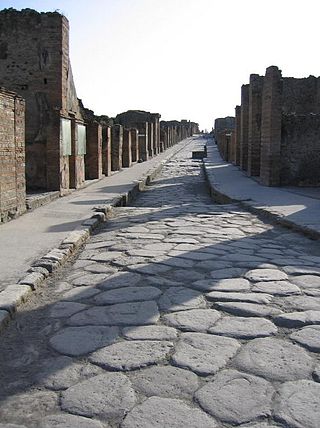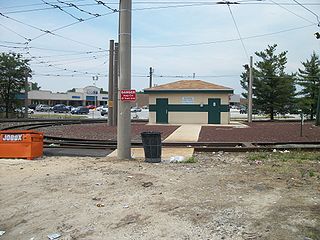
Commuter rail or suburban rail is a passenger rail transport service that primarily operates within a metropolitan area, connecting commuters to a central city from adjacent suburbs or commuter towns. Commuter rail systems can use locomotive-hauled trains or multiple units, using electric or diesel propulsion. Distance charges or zone pricing may be used.
The vast majority of passenger travel in the United States occurs by automobile for shorter distances and airplane or railroad for longer distances. Most cargo in the U.S. is transported by, in descending order, railroad, truck, pipeline, or boat; air shipping is typically used only for perishables and premium express shipments. Transportation is the largest source of greenhouse gas emissions in the United States.

Memphis is a city in the U.S. state of Tennessee. It is the county seat of Shelby County, in the southwesternmost part of the state, and is situated along the Mississippi River. With a population of 633,104 at the 2020 U.S. census, Memphis is the second-most populous city in Tennessee after Nashville.

A sidewalk or pavement is a path along the side of a road. Usually constructed of concrete, pavers, brick, stone, or asphalt, it is designed for pedestrians. A sidewalk is normally higher than the roadway, and separated from it by a curb. There may also be a planted strip between the sidewalk and the roadway and between the roadway and the adjacent land.

New Urbanism is an urban design movement that promotes environmentally friendly habits by creating walkable neighbourhoods containing a wide range of housing and job types. It arose in the United States in the early 1980s, and has gradually influenced many aspects of real estate development, urban planning, and municipal land-use strategies. New Urbanism attempts to address the ills associated with urban sprawl and post-WW II suburban development.

Lady Bird Lake is a river-like reservoir on the Colorado River in Austin, Texas, United States. The City of Austin created the reservoir in 1960 as a cooling pond for a new city power plant. The lake, which has a surface area of 416 acres (168 ha), is now used primarily for recreation and flood control. The reservoir is named in honor of former First Lady of the United States Lady Bird Johnson.

Urban renewal is a program of land redevelopment often used to address urban decay in cities. Urban renewal involves the clearing out of blighted areas in inner cities in favour of new housing, businesses, and other developments.

The City Beautiful movement was a reform philosophy of North American architecture and urban planning that flourished during the 1890s and 1900s with the intent of introducing beautification and monumental grandeur in cities. It was a part of the progressive social reform movement in North America under the leadership of the upper-middle class, which was concerned with poor living conditions in all major cities. The movement, which was originally associated mainly with Chicago, Cleveland, Detroit, Kansas City and Washington, D.C., promoted beauty not only for its own sake, but also to create moral and civic virtue among urban populations.

A tram-train is a type of light rail vehicle that both meets the standards of a light rail system, and also national mainline standards. Tramcars are adapted to be capable of running on streets like an urban tramway but also be permitted operation alongside mainline trains. This allows services that can utilise both existing urban light rail systems and mainline railway networks and stations. It combines the urban accessibility of a tram or light rail with a mainline train's greater speed in the suburbs.

Downtown Las Vegas is the central business district and historic center of Las Vegas, Nevada, United States. It is the original townsite, and the Downtown gaming area was the primary gambling district of Las Vegas prior to the Strip. As the urban core of the Las Vegas Valley, it features a variety of hotel and business highrises, cultural centers, historical buildings and government institutions, as well as residential and retail developments. Downtown is located in the center of the Las Vegas Valley and just north of the Las Vegas Strip, centered on Fremont Street, the Fremont Street Experience and Fremont East. The city defines the area as bounded by I-15 on the west, Washington Avenue on the north, Maryland Parkway on the east and Sahara Avenue on the south.

Downtown Memphis is the central business district of Memphis, Tennessee, and is located along the Mississippi River between Interstate 40 to the north, Interstate 55 to the south, and Interstate 240 to the east, where it abuts Midtown Memphis.

Mixed use is a type of urban development, urban design, urban planning and/or a zoning classification that blends multiple uses, such as residential, commercial, cultural, institutional, or entertainment, into one space, where those functions are to some degree physically and functionally integrated, and that provides pedestrian connections. Mixed-use development may be applied to a single building, a block or neighborhood, or in zoning policy across an entire city or other administrative unit. These projects may be completed by a private developer, (quasi-)governmental agency, or a combination thereof. A mixed-use development may be a new construction, reuse of an existing building or brownfield site, or a combination.

Hermann Park is a 445-acre (180-hectare) urban park in Houston, Texas, situated at the southern end of the Museum District. The park is located to the immediate north end of the MD Anderson Cancer Center at Texas Medical Center and Brays Bayou, east of Rice University, and slightly west of the Third Ward. Hermann Park is home to numerous cultural institutions including the Houston Zoo, Miller Outdoor Theatre, the Houston Museum of Natural Science, and the Hermann Park Golf Course, which became one of the first desegregated public golf courses in the United States in 1954. The park also features the Mary Gibbs and Jesse H. Jones Reflection Pool, numerous gardens, picnic areas, and McGovern Lake, an 8-acre (32,000 m2) recreational lake.

Eastwick is a neighborhood in the Southwest section of Philadelphia, Pennsylvania, United States. It is the southwesternmost neighborhood in the city, bordering Philadelphia International Airport and the city line with Delaware County at Cobbs Creek and Darby Creek. The Elmwood Park neighborhood borders it to the northeast. It includes the Clearview neighborhood.

The San Diego Metropolitan Transit System is a public transit service provider for San Diego County, California. The agency operates a transit system that includes the San Diego MTS bus system, San Diego Trolley, and Rapid. MTS also controls the San Diego and Arizona Eastern (SD&AE) freight railway and regulates taxicabs, jitneys, and other private for-hire passenger transportation services.

Streetcars or trolley(car)s were once the chief mode of public transit in hundreds of North American cities and towns. Most of the original urban streetcar systems were either dismantled in the mid-20th century or converted to other modes of operation, such as light rail. Today, only Toronto still operates a streetcar network essentially unchanged in layout and mode of operation.
Highway beautification is landscaping intended to enhance the attractiveness of roads, preserve scenic beauty, and control of the usage of the land near highways. This may include vegetation, irrigation, street furniture, decorative pavings, fences, and lighting. Benefits from highway beautification include reduction in driving stress, improved visual quality, and improved roadway safety, with cities citing decreases in total number of crashes after beautification projects. However, in some places, objects that may become hazards to erratic vehicles may be banned in projects, such as trees, large shrubs, boulders, dirt mounds, or concrete sections as improper landscaping can reduce visibility or increase roadway debris. Highway beautification may occur in urban, semi-urban, or rural areas.
The term percent for art refers to a program, often a city ordinance, where a fee, usually some percentage of the project cost, is placed on large scale development projects in order to fund and install public art. The details of such programs vary from area to area. Percent for art programs are used to fund public art where private or specialized funding of public art is unavailable. Similar programs, such as "art in public places", attempt to achieve similar goals by requiring that public art be part of a project, yet they often allow developers to pay in-lieu fees to a public art fund as an alternative.
Memphis, Tennessee is governed by a mayor and thirteen city council members. Since 1995, as a result of a legal challenge, all council members are elected from nine geographic districts. Seven are single-member districts and two have three representatives each.
The Demonstration Cities and Metropolitan Development Actof 1966 was enacted by the United States Congress to guarantee that federal grants were being spent on set projects in urban redevelopment. It was enacted as a broad urban planning program meant to revitalize cities and improve the welfare of people living in underdeveloped neighborhoods. The act provided aid to cities rebuilding blighted areas, while also offering measures that dealt with mass transit, beautification, conservation, water and air quality, public safety, and support for the arts and humanities.














